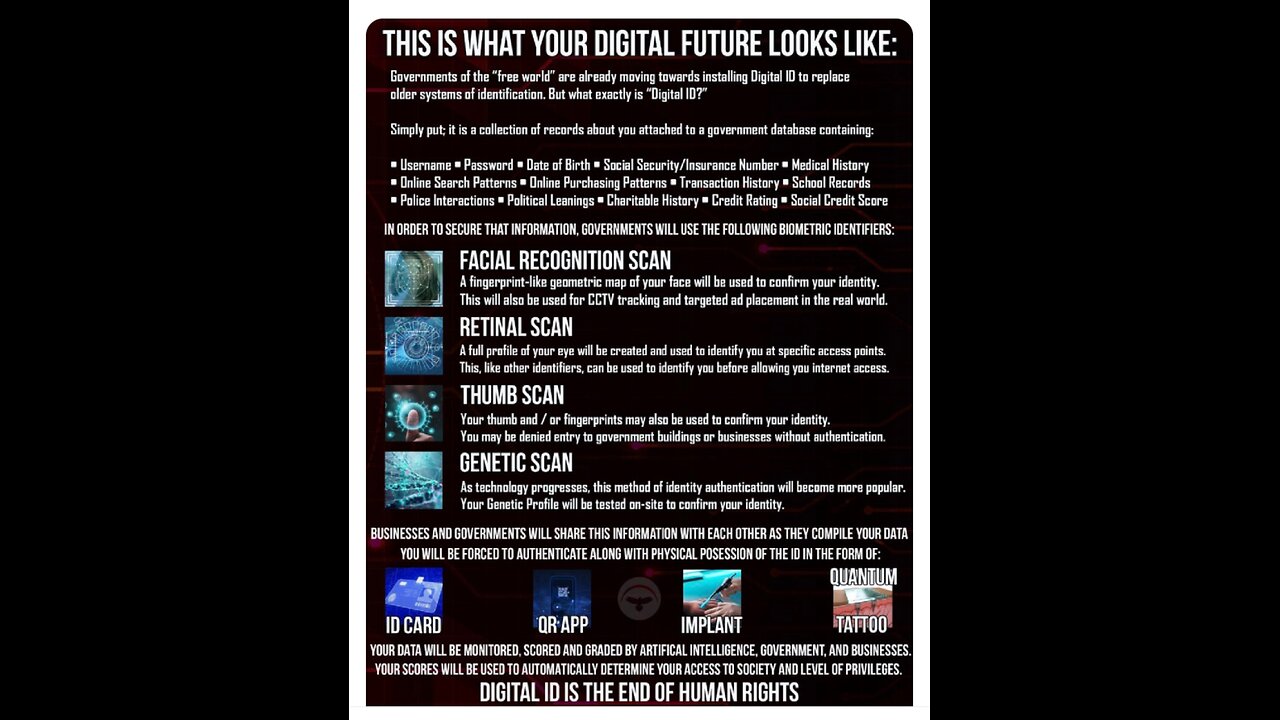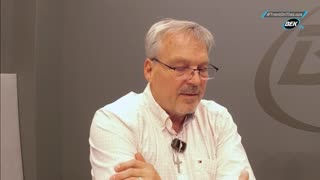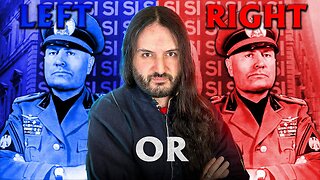Premium Only Content

The Danger of Seeing What Others Don’t
The Danger of Seeing What Others Don’t
It's not hard to see why so many people miss the forest for the trees—or the nose on their own faces. The majority who even hear those sayings don't grasp their meaning, much less act out the behaviors and thought processes needed to truly understand why they exist in the first place.
That's just the tip of the iceberg. What's truly remarkable is how masses of people in what we call the most advanced society ever are utterly incapable of mentally simulating a simple process to uncover the real reason behind a saying. They're content to stumble through life as clueless golems and zombies—terms they misunderstand as mere "walking dead" from some TV show, oblivious to their deeper roots in soulless automatons and mindless hordes.
The worst part?
They refuse to acknowledge this ignorance, let alone correct it, ignoring the ripple effects that cripple their ability to grasp even the most basic first principles.
Things like decoding language: its origins, historical shifts in connotation, and why etymology matters as a factual lens on reality.
Without that foundation, how can anyone judge right from wrong—especially when it dictates freedom or imprisonment?
Imagine a courtroom where you're accused of a tragedy you had no part in. They bar you from establishing a proper timeline of events, actions, and behaviors. Their "evidence" captures you stepping out the door just as the horror unfolds inside—but rewind 30 seconds, and the real perpetrators are caught in the act. Video exists; access is there. Yet they hit play without rewinding, condemning you on a fabricated sequence.
Sound familiar?
That's the blindness we're up against daily, and as @Real.T.Dolceacqua has long warned, it's no accident—it's engineered.
Take the Charlie Kirk tragedy: footage shown only seconds after the shot, while multiple rooftop cameras hold hours of prelude, including the suspect scrambling into position. The timeline screams for a simple rewind—under 60 seconds—to reveal the truth. But the government, the entire two-party machine, insists you can't look back. They claim no rewind button exists, no way to build an accurate sequence for a life-or-death event.
When the tools are right there for anyone to use, this isn't incompetence; it's a deliberate veil over first-principles cause and effect.
Let that sink in: If you can't force yourself to see this—if emotions or daily distractions keep you from the facts, if you march along this path—you're complicit in the same evil.
As @TjsweetwaterTrueNewsNViews nailed it years ago, ignoring the timeline isn't just lazy; it's choosing unconsciousness over awareness, blind spots over situational clarity for yourself and your fellow Americans.
Without timelines, cause and effect dissolve into chaos. Problems arise from unseen actions, yet we debate effects without tracing roots. Why speak on anything if you're unwilling to do the obvious: rewind, reconstruct, awaken? Refuse that, and facts become optional—points of failure, ignored. You're not just unaware; you're actively opting out of consciousness itself.
As @TjSweetwater so prophetically put it, the truth has been staring us down, but only those who hit rewind will see it. Time to wake up.
Everything That I have recorded in Compilations of truth by many different people from every single walk of life.
The Truth shall set you free from the Jones Plantation we all live on today.
If you believe it or don't believe it.
It doesn't care what you believe or think, the truth is there, it's always been here and will always be here, even if you don't believe it or understand it or not.
F - ear
A - uthority
T - ribe
E - motions
#ChaseHughes
#NCUUniversity
#ShawnRyan
#ShawnRyanShow
#TjSweetwaterTrueNewsNTrueViews
The one we've been waiting for, let’s fucken goooooooo!!!
Proving everything that I have said for years.
↘️⬇️↙️
https://youtu.be/4p3kNCrJ31w?si
https://youtu.be/4p3kNCrJ31w?si=ZT82nyhkQYubm9Il
https://youtube.com/shorts/oKMQVOlLleA?si=AfvIK6y5fue2dErQ
https://linktr.ee/tjsweetwaterwasright
Insights from Behavioral Science on Violence, Modeling, and Human Development
In an era that echoes the authoritarian echoes of history's darkest chapters, it's crucial to confront a uncomfortable truth: fear is not discipline. Far from fostering self-regulation, fear operates as a form of psychological violence, yielding short-term compliance at the expense of long-term emotional health.
Yet, as behavioral scientists have long documented through studies on stress responses and attachment theory, violence—whether physical or emotional—perpetuates cycles of aggression rather than resolution. Society decries the pervasive violence in our communities, yet we often justify coercive tactics to address mental health challenges and behavioral issues. This contradiction ignores foundational principles of how the human brain develops and adapts.
At its core, problematic behavior in children and adolescents is frequently a mirror of the adults around them—a phenomenon rooted in social learning theory, where modeling shapes conduct more powerfully than words alone. As Albert Bandura's classic Bobo doll experiments illustrated, children imitate observed behaviors, internalizing them as normative. They emulate what we do, not merely what we say. Involving law enforcement in these familial or developmental matters only escalates the dynamic, transforming teachable moments into adversarial confrontations that reinforce distrust and reactivity.
Consider this: Do we apply the same coercive strategies to our intimate partners, invoking fear to enforce compliance in our marriages? Do we wield such tactics against colleagues in the workplace, dismissing dialogue for dominance? Or do we extend this rationale to political adversaries, rationalizing aggression toward those whose views diverge from our own? It's a selective hypocrisy that undermines social cohesion.
Small wonder, then, that our nation grapples with escalating interpersonal and structural violence—outcomes predicted by research on intergenerational transmission of trauma, where unresolved parental patterns echo across generations.
This pattern manifests starkly in our treatment of youth. We deny teenagers the autonomy to behave as maturing adults in safe contexts, while simultaneously recruiting them into military service, conditioning them through rigorous operant techniques to become instruments of sanctioned lethality—all in service of geopolitical narratives that behavioral economists term "framing effects" gone awry. Such inconsistencies erode prefrontal cortex development, the brain region responsible for impulse control and empathy, as neuroimaging studies consistently show.
Examine the prison system, a microcosm of institutionalized coercion: its culture thrives on dominance hierarchies and retributive violence, breeding tribalism and recidivism rather than rehabilitation. Meta-analyses in criminology reveal that punitive environments fail to rewire maladaptive schemas, instead amplifying them through heightened cortisol levels and disrupted neural pathways.
True behavioral change demands education in emotional intelligence, mindfulness, and cognitive-behavioral frameworks—not escalation.
If one adheres to the antiquated notion that violence is the sole avenue for instilling discipline in youth, it reveals a profound misunderstanding of neuroplasticity and reinforcement schedules. Such an approach aligns not with evidence-based practice but with outdated stimulus-response models, akin to a zookeeper subduing an animal through force rather than enrichment. It breaks spirit without building resilience.
A more enlightened path emerges from applied ethology, as exemplified by Cesar Millan, the renowned "dog whisperer." Millan's methods eschew punishment in favor of pack dynamics and energy calibration—exhausting maladaptive responses through structured, non-violent exposure until calmer states prevail. This mirrors exposure therapy in human behavioral interventions, where gradual desensitization rewires fear circuits without trauma.
From a neurobiological lens, the imperative for non-violence becomes even clearer. The brain serves as the central executive for our body's approximately 50 trillion cells, orchestrating homeostasis via electrochemical signaling.
Just as unchecked aggression disrupts this symphony—leading to chronic inflammation and allostatic load—imposing violence on oneself or others sabotages adaptive learning. Consider organ transplantation: to prevent catastrophic rejection, we deliberately suppress the immune response, averting a violent cellular insurrection against the "foreign" invader.
This first-principles biology underscores a universal truth: harmony, not hostility, sustains viability. As Dr. Bruce Lipton elucidates in his work on epigenetics, environmental cues—positive or coercive—directly influence gene expression, shaping cellular behavior across scales from the individual to the collective.
This principle extends to vulnerable populations. Would we resort to physical force or police intervention for an elderly person grappling with dementia or late-life anxiety?
Intuition, backed by geriatric psychology, says no—such responses would exacerbate agitation and sundowning. Yet we inconsistently apply this compassion to children and adolescents, whose brains remain under construction until the mid-20s, with underdeveloped executive functions rendering them particularly susceptible to modeling over mandates.
In my own experience as a parent, eschewing corporal punishment yielded profound results. My son was raised not through fear or resentment, but through relational accountability—clear, empathetic explanations of consequences, paired with vivid, relatable examples. He learned to value disappointing harmful actions over dreading authority, fostering intrinsic motivation rather than extrinsic control.
From infancy through age seven—a critical window before full conscience and self-awareness solidify—we prioritized co-regulation over isolation, aligning with developmental milestones outlined in Piaget's stages.
For deeper validation, I recommend The Biology of Belief by Dr. Bruce Lipton, which bridges cellular biology with consciousness, or his accessible YouTube lectures on epigenetics and environmental influences on behavior.
These resources demystify how belief systems—personal and societal—literally reprogram our biology.
Embracing these insights isn't merely aspirational; it's a paradigm shift with cascading benefits. By prioritizing modeling, empathy, and evidence-informed strategies over violence, we cultivate resilient individuals and cohesive societies.
The sooner we integrate behavioral science into our cultural fabric—from parenting to policy—the brighter the prospects for global well-being.
The Danger of Seeing What Others Don’t - Carl Jung
📕 Perception Training for Empaths: Book + 3 Exclusive Videos → https://shorturl.at/72zZL
#News,#Politics,#ChaseHughes,#ShawnRyan,#TjSweetwater,#TjsweetwaterTrueNewsNTrueViews,#Covid19,#NCUniversity,#NWO,#PersuasiveTechnology,#TjSweetwatersTruthChannel,#CarlJung,#DangersOfSeeing,#SeeingWhatOthersDont,#PsyOps
-
 13:22
13:22
Silver Dragons
16 hours agoAre You Prepared for What SILVER Will Do Next?
8953 -
 9:20
9:20
Adam Does Movies
18 hours ago $0.10 earnedIT: Welcome To Derry Episode 4 Recap - What An Eyesore
2481 -
 LIVE
LIVE
LIVE WITH CHRIS'WORLD
10 hours agoTHE WAKE UP CALL - 11/24/2025 - Episode 12
319 watching -
 LIVE
LIVE
BEK TV
2 days agoTrent Loos in the Morning - 11/24/2025
161 watching -
 LIVE
LIVE
The Bubba Army
2 days agoF1'S NEWEST DRIVER? - Bubba the Love Sponge® Show | 11/24/25
1,749 watching -
 19:15
19:15
Nikko Ortiz
19 hours agoOstrich Gets A Taste For Human Blood
55.2K16 -
 32:42
32:42
MetatronHistory
1 day agoWas FASCISM Left wing or Right wing?
9.01K32 -
 LIVE
LIVE
Flex011
5 hours ago $0.01 earnedFrom Scrap to Stronghold: Our Base is Live!
80 watching -
 9:52
9:52
MattMorseTV
14 hours ago $15.43 earnedTrump just GAVE the ORDER.
18.7K53 -
 LIVE
LIVE
PudgeTV
1 hour ago🟣 Arc Raiders - Gaming on Rumble | Monday Madness
63 watching